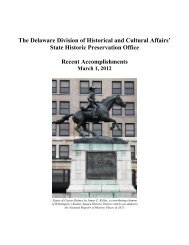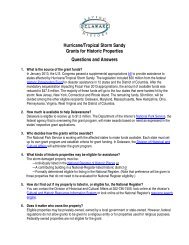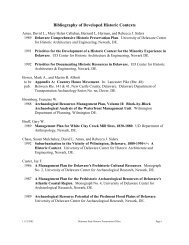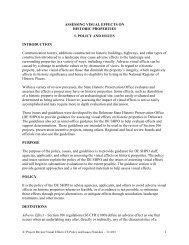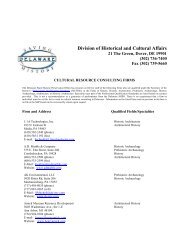Report of the Archaeological Investigations of the New Castle Court ...
Report of the Archaeological Investigations of the New Castle Court ...
Report of the Archaeological Investigations of the New Castle Court ...
You also want an ePaper? Increase the reach of your titles
YUMPU automatically turns print PDFs into web optimized ePapers that Google loves.
NEW CASTLE COURT HOUSE PLAZA<br />
NEW CASTLE, DELAWARE<br />
4.0 ARTIFACT ANALYSIS<br />
4.1 THE FAUNA FROM NEW CASTLE COURT HOUSE<br />
4.0 ARTIFACT ANALYSIS<br />
All toge<strong>the</strong>r 1,323 bones and bone fragments were recovered from two features and a variety <strong>of</strong><br />
field contexts at <strong>the</strong> site <strong>of</strong> <strong>the</strong> <strong>New</strong> <strong>Castle</strong> <strong>Court</strong> House plaza (7NC-E-105A). A total <strong>of</strong> 275<br />
bones were recovered from Feature 19 (SU E) and Feature 20 yielded 759 bones. An additional<br />
289 bones came from small features and unassociated contexts. Although both features appear to<br />
be fill, yard midden, or secondary trash deposits, <strong>the</strong> assemblages deposits yielded were likely <strong>the</strong><br />
remains <strong>of</strong> meals. The association <strong>of</strong> <strong>the</strong>se deposits with a <strong>Court</strong> House allows for potential<br />
comparisons with early tavern assemblages that were <strong>of</strong>ten associated with public buildings or<br />
o<strong>the</strong>r governmental structures.<br />
In <strong>the</strong> course <strong>of</strong> analysis, <strong>the</strong> processes that impact site formation were considered. The<br />
wea<strong>the</strong>ring <strong>of</strong> <strong>the</strong> majority <strong>of</strong> <strong>the</strong> bones in both features indicates that nei<strong>the</strong>r assemblage was<br />
recovered from a sealed or undisturbed context. The fauna from Feature 19 came from a fill<br />
deposit directly overlying <strong>the</strong> subsoil on <strong>the</strong> east plaza. This level may have been open to <strong>the</strong><br />
elements or <strong>the</strong> materials deposited at this location after first being disposed <strong>of</strong> elsewhere. The<br />
assemblage from Feature 20 was similar in appearance. With many wea<strong>the</strong>red and worn bones,<br />
this seems to have been a secondary trash deposit, used to fill a cellar hole or o<strong>the</strong>r open space<br />
that was no longer in use. Based on <strong>the</strong> composition <strong>of</strong> <strong>the</strong> faunal assemblages and stratigraphy,<br />
<strong>the</strong>se deposits were short in duration, perhaps single episodes <strong>of</strong> site cleaning and filling.<br />
Due to <strong>the</strong> fragmented nature <strong>of</strong> <strong>the</strong> assemblages, <strong>the</strong> number <strong>of</strong> mammal bones identified was<br />
probably an over-representation <strong>of</strong> species present. When compared to <strong>the</strong> smaller and more<br />
fragile bird and fish bones, those <strong>of</strong> large mammals were far more likely to survive postdepositional<br />
disturbances and environmental changes. Additionally, standard field recovery and<br />
artifact processing favors recovery <strong>of</strong> <strong>the</strong> largest animals and body parts. Within Feature 19, a<br />
single context was water-screened (158) and it was from here that bones from smaller animals<br />
and fish were recovered.<br />
The fragmented and wea<strong>the</strong>red remains <strong>of</strong> <strong>the</strong> large mammals recovered from Feature 19 (SU E)<br />
suggested this was not a primary deposit or alternately that <strong>the</strong> bones were exposed to wea<strong>the</strong>r or<br />
trampling for some undetermined period <strong>of</strong> time. There was no discernable pattern <strong>of</strong> deposition<br />
or bone distribution among <strong>the</strong> EUs assigned to Feature 19, nor did analysis suggest a particular<br />
use or pattern <strong>of</strong> waste disposal. Small quantities <strong>of</strong> turtle, rabbit, and mouse/vole bones indicate<br />
that some <strong>of</strong> Feature 19 was probably accessible or open to small scavengers for a period <strong>of</strong> time.<br />
The bones <strong>of</strong> <strong>the</strong>se animals were recovered in small numbers from EU 27, Level 2 which was<br />
water-screened.<br />
By comparison, Feature 20 was both larger and more interesting with respect to <strong>the</strong> number <strong>of</strong><br />
bones recovered and <strong>the</strong> species present. With large butchered mammal bones and several species<br />
<strong>of</strong> fish and birds, much <strong>of</strong> Feature 20 may have been <strong>the</strong> remains <strong>of</strong> meals. In addition to large<br />
food mammals, three common species <strong>of</strong> fish and three types <strong>of</strong> food birds were identified. Most<br />
<strong>of</strong> <strong>the</strong> bones came from within EU 8 (contexts 43, 44, and 48). Again, fragmentation and<br />
wea<strong>the</strong>ring was evident on many <strong>of</strong> <strong>the</strong> bones and this assemblage may represent a secondary fill<br />
or trash deposit within <strong>the</strong> cellar hole. No rodents were recovered from Feature 20, but it was<br />
unlikely <strong>the</strong> nearly complete box turtle (25 fragments from EU 8 [context 48]) served as food. A<br />
damp and muddy partially filled cellar hole might have provided an accessible place for<br />
hibernation or scavenging (Beisaw 2000).<br />
57





